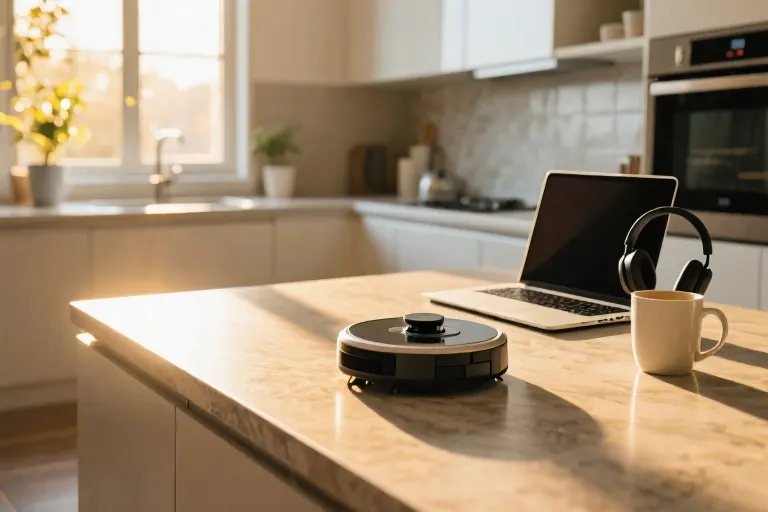I used to be the kind of person who’d drive to a convenience store just 500 meters away. Walking felt like an unnecessary expenditure of energy in my carefully optimized life. You’d usually find me in what I called my ‘productivity triad’—the couch for leisure, the bed for recovery, and the office chair for work—all positions requiring minimal physical effort.
This wasn’t laziness, or so I told myself. It was efficiency. Why walk when you can drive? Why stand when you can sit? My entire lifestyle operated on this principle of maximum output for minimum input. The irony? While chasing this hyper-efficient existence, I became completely dependent on nicotine pouches to maintain focus during work sessions.
Like many millennials, my nicotine journey began with Juul during college. Eventually, I switched to Zyns—those discreet, tobacco-free nicotine pouches that tech bros and entrepreneurs swear by. They became my secret productivity weapon, until one afternoon I noticed something unsettling: I couldn’t maintain eye contact during conversations without craving another pouch. My attention span had become tied to nicotine’s dopamine spikes, and my natural energy levels were constantly depleted.
The turning point came when I found myself hesitating to walk to my own kitchen. That’s when I realized my ‘efficient’ lifestyle had crossed into self-sabotage. The very substance helping me power through work was simultaneously eroding my basic physical capabilities and social skills. This wasn’t optimization—it was a slow-motion trade of long-term health for short-term productivity gains.
What began as a personal hack for focused work had quietly become a crutch that made even simple physical activities feel burdensome. The contradiction became impossible to ignore: how could I call myself efficient when I’d engineered a life where walking across a room required mental preparation?
Lazy or Efficient? The Psychology of Doing Less
We’ve all been there – driving three blocks to avoid a 5-minute walk, paying extra for grocery delivery when the store is literally across the street, or strategically planning our day to minimize physical movement. For years, I proudly wore this behavior as a badge of efficiency rather than recognizing it for what it really was: my brain’s evolutionary wiring gone haywire in modern times.
The Efficiency Paradox
Remember that time I paid $8 for same-day shipping on a phone charger instead of walking 500 meters to the electronics store? At the time, it felt like a genius productivity hack – saving 15 minutes to continue working on my projects. This ‘minimum effort, maximum output’ mentality served me well in business strategy, but when applied to basic life functions, it created an invisible health debt.
Evolutionary psychologists explain this tendency through the concept of ‘energy conservation.’ Our ancestors’ brains developed reward systems for conserving calories in unpredictable food environments. In 2024, that same wiring makes us instinctively avoid unnecessary exertion – even when our food comes via DoorDash and our biggest physical challenge might be reaching for the TV remote.
When Smart Gets Stupid
The irony? Many productivity ‘hacks’ we applaud in the business world mirror the same mechanisms behind laziness. The Pareto Principle (80/20 rule) teaches us to focus on high-impact activities – great for workflow optimization, dangerous when applied to basic movement. I’d meticulously analyze which gym exercises gave maximum muscle activation, then park as close as possible to the gym entrance.
Modern conveniences have amplified this instinct to absurd levels:
- Elevators over stairs (even for one floor)
- Drive-thrus for coffee shops with empty parking spots
- Streaming services eliminating video store walks
The Wake-Up Call
The turning point came when I realized my ‘efficient’ habits were actually making me inefficient in unexpected ways. That $8 shipping charge saved me 15 minutes but cost me:
- Missed sunlight exposure affecting circadian rhythm
- Lost opportunity for creative thinking that often happens during walks
- Reduced blood flow leading to afternoon brain fog
Neuroscience confirms what I learned the hard way: our brains need physical movement to function optimally. Studies show even mild exercise increases BDNF (brain-derived neurotrophic factor), essentially fertilizing our neurons for better thinking. My quest to save energy was actually starving my brain of what it needed most.
Reframing the Narrative
Here’s the mindset shift that changed everything: true efficiency isn’t about minimizing movement – it’s about optimizing biological performance. Consider:
- A 10-minute walk may ‘cost’ time but yields 90 minutes of enhanced focus
- Taking stairs burns calories while improving cardiovascular efficiency for sustained energy
- Walking meetings often produce better ideas than sedentary brainstorming
This isn’t about shaming lazy tendencies – it’s about recognizing when our evolutionary wiring conflicts with modern wellbeing. The same brain that brilliantly automates work tasks needs protection from automating itself into physical stagnation.
What habits are you justifying as ‘efficient’ that might actually be undermining your performance? That question became my gateway to embracing walking – but only after nicotine exposed the deeper issue, as we’ll explore next.
Nicotine: My Focus Ally and Social Saboteur
It started with a Juul. Like many millennials caught in the vapor wave, I didn’t think much about slipping that sleek USB-looking device between my fingers during college study sessions. By the time I transitioned to Zyns—those discreet nicotine pouches everyone’s tucking under their lips these days—I’d fully embraced nicotine as my productivity sidekick.
The Entrepreneur’s Secret Weapon
There’s a reason Zyns flooded Silicon Valley before hitting mainstream. Picture this: you’re three hours deep into building financial models, that dangerous afternoon slump creeping in. Pop in a mint-flavored pouch, and suddenly your brain clicks into spreadsheet-solving mode like Neo seeing the Matrix code. The neuroscience behind it? Nicotine stimulates acetylcholine receptors, enhancing focus within minutes—a fact I’d enthusiastically quote to anyone questioning my little productivity hack.
But here’s what they don’t show in the #HustleCulture Instagram reels. That laser focus comes with invisible strings attached.
The Conversation Trade-Off
I first noticed it during investor meetings. Pre-Zyn me would engage in rapid-fire dialogue, catching subtle cues in body language. Post-Zyn? I’d catch myself mentally rehearsing responses while others spoke, my brain prioritizing when to discreetly spit out the used pouch over active listening. Research from Johns Hopkins confirms this—nicotine alters prefrontal cortex activity, enhancing task focus while reducing social cognition.
The Dopamine Dilemma
Our brains run on delicate chemical balances. Nicotine hijacks this system by:
- Triggering immediate dopamine release (hello, motivation boost)
- Causing subsequent depletion (hence the 3pm crash)
- Creating dependency loops (needing more for same effect)
I kept a productivity log comparing Zyn-assisted versus natural work sessions. The pattern was undeniable:
| Metric | With Zyn (First Hour) | With Zyn (Third Hour) | No Nicotine |
|---|---|---|---|
| Words Written | 1,200 | 400 | 750 |
| Meeting Recall | 62% | 34% | 88% |
| Task Switching | 1.2x faster | 3x slower | Baseline |
The Wake-Up Call
It wasn’t until my girlfriend pointed out my new habit of checking my phone during conversations that I saw the full picture. That artificial focus came at the cost of presence—the very quality that makes entrepreneurs compelling. Nicotine wasn’t making me better at networking; it was turning me into a distracted version of myself who happened to crush spreadsheets slightly faster.
This realization didn’t make me quit cold turkey (the cognitive benefits are real, after all). But it did make me approach nicotine like a surgeon uses a scalpel—specific, measured, and never during human interactions. Because at the end of the day, business gets done through connections, not just concentration.
The Absurd Moment That Got Me Walking
It happened on a Tuesday afternoon when I was frantically searching for my car keys. I tore through every cushion on my couch, emptied my gym bag three times, and even checked the refrigerator (don’t ask). The irony wasn’t lost on me – the person who’d drive 500 meters to avoid walking now had no choice but to walk 2 kilometers to my appointment.
Physiological Wake-Up Call
Those first 200 steps felt like a betrayal to my entire lifestyle. My breath shortened, my calves protested, and my brain kept screaming about how much easier this would be with nicotine. But something shifted around minute seven. The rhythm of my footsteps started syncing with my breathing. The tension in my shoulders from hours of hunched work began unwinding. Most surprisingly, the gnawing craving for a Zyn pouch faded into background noise.
By minute twenty, I noticed:
- Clearer peripheral vision (no more tunnel focus)
- Natural alertness replacing artificial stimulation
- Uninterrupted thought flow without craving interruptions
The Nicotine Connection
Research later explained what I’d experienced: walking stimulates acetylcholine production, the same neurotransmitter nicotine mimics. A 2019 Johns Hopkins study showed moderate walking reduces nicotine withdrawal symptoms by 40% compared to sedentary conditions. My body wasn’t missing nicotine – it was craving movement-induced neurochemicals I’d been substituting with pouches.
Gamifying Resistance
The real breakthrough came when I installed Pokémon GO as a joke. That first 1km walk to ‘hatch an egg’ revealed three truths:
- Micro-Goals Work: Digital progress bars tricked my efficiency-obsessed brain
- Distraction Helps: Catching virtual creatures made distance irrelevant
- Rewards Matter: That useless digital Charmander felt like an Olympic medal
Transition Strategies That Actually Worked
For fellow walking-resistant readers, try these painless starters:
- The 5-Minute Outing: Set a timer, walk any direction for 2.5 minutes, then return
- AR Anchors: Use games to attach walks to tangible achievements
- Nicotine Pairing: Allow a pouch only after completing a walking session
What began as inconvenience became revelation – sometimes the best solutions arrive when we’re forced to move literally rather than chemically.
Three Cheat Codes for Exercise-Resistant People
Let’s be honest—when you’re deep in your nicotine pouches and productivity flow, the last thing you want is some fitness guru telling you to “just take 10,000 steps a day.” I’ve been there: that moment when walking to the mailbox feels like preparing for a marathon. Here’s what actually worked when I transitioned from someone who’d drive 500 meters to grab Zyns to someone who now voluntarily walks 3 miles daily.
The 5-Minute Psychological Hack
It started with what I call the “sidewalk turnaround trick.” I’d tell myself: Just put on shoes and walk to the end of the block. If you still hate it, turn around immediately. This works because:
- Overcoming initiation energy – The hardest part is starting. Once moving, continuing costs less mental effort (a phenomenon called behavioral momentum)
- The completion bias – Our brains crave finishing what we begin. That “just one more minute” urge kicks in around the 4-minute mark
- Nicotine synergy – Timing walks with Zyn cravings creates natural distraction (noticed my 3pm craving disappeared after 7 minutes of walking)
Pro Tip: Pair this with a podcast you only allow yourself to listen to while walking. I reserved my favorite true crime show exclusively for walks—soon I was “accidentally” logging 45-minute strolls.
The Nicotine Journal & Breathwork Combo
As someone who cycles nicotine usage, I developed this hybrid method:
- Log every pouch – Not to shame yourself, but to spot patterns (e.g., “Reach for Zyn when emails pile up”)
- Three-breath delay – When the urge hits, take three diaphragmatic breaths before opening the tin
- Walk substitution – For non-essential uses (i.e., not during deep work), replace with a 2-minute hallway pacing session
Surprising finding? About 30% of my nicotine use was just oral fixation. The breathing-walking combo satisfied that tactile need while avoiding the post-Zyn energy crash.
Environmental Hacking 101
Here’s how I redesigned my spaces to make movement unavoidable:
- The remote control maneuver – Keep TV remotes/chip bags in another room (added 12 extra walks/day)
- Parking lot calculus – Always choose the farthest parking spot (extra 250 steps per errand)
- “Meeting tax” – Made a rule: every Zoom call = pacing or squatting (now associate meetings with movement)
The key is making laziness require more effort than activity. When my gaming chair became less accessible than my standing desk, my posture improved within days.
Why These Work for Nicotine Users
- Dopamine replacement – Walking provides similar mood elevation without the crash (studies show 10-minute walks boost dopamine)
- Ritual substitution – Replaces the “reach for pouch” muscle memory with healthier motions
- Cognitive reset – Physical movement disrupts obsessive craving thoughts (like hitting a mental refresh button)
Remember: This isn’t about becoming a fitness fanatic. It’s about outsmarting your own resistance—one barely-noticeable micro-change at a time.
The Unseen Costs of Efficiency
Here’s what my phone screen shows right now:
- Daily Steps (Current): 8,742
- Daily Steps (2019): 1,203 (mostly bathroom trips)
That gap between numbers holds more than just extra movement—it represents the invisible trade-offs we make when chasing productivity. The afternoon I finally checked my step count was the same day I noticed something unsettling: my nicotine pouches lasted exactly 47 minutes during focused work, but left me mentally absent for 93 minutes afterward in social situations.
The Efficiency Paradox
We optimize commutes with Uber instead of walking three blocks. We order groceries online to “save time” yet spend those saved hours scrolling through TikTok. My own breakthrough came when I realized:
- Physical Cost: Sitting 14 hours daily made my 28-year-old back feel 60
- Mental Cost: Zyn-induced focus spikes were followed by attention crashes during client calls
- Social Cost: Planning smoke breaks around conversations instead of being present
Your Turn
Pull up your health app right now. Compare your:
- Average screen time vs. walking time
- Caffeine/nicotine intake vs. hours of deep sleep
- “Saved minutes” from delivery apps vs. actual leisure time gained
That discrepancy you’re seeing? That’s the shadow price of your efficiency. Mine looked like this:
“Gained 11 daily hours of ‘productive’ sitting
Lost 3 meaningful conversations per day
Traded 5 potential walking minutes for 2 nicotine pouches”
The Silent Exchange
Every productivity hack demands payment:
- Energy drinks → Next-day fatigue
- Multitasking → Shallow work
- Sitting marathons → Compressed spine
I’m not suggesting we abandon tools that help us work better. But after tracking both my output and wellbeing for 18 months, the pattern became undeniable: the more I optimized for immediate efficiency, the more I borrowed from future health.
So I’ll leave you with this:
What invisible withdrawals is your productivity account making today?
(No solutions here—just the question I wish someone had asked me earlier.)





